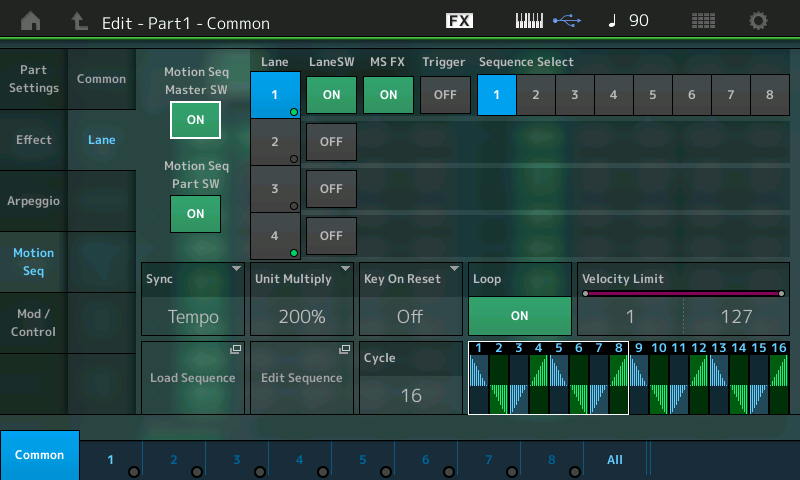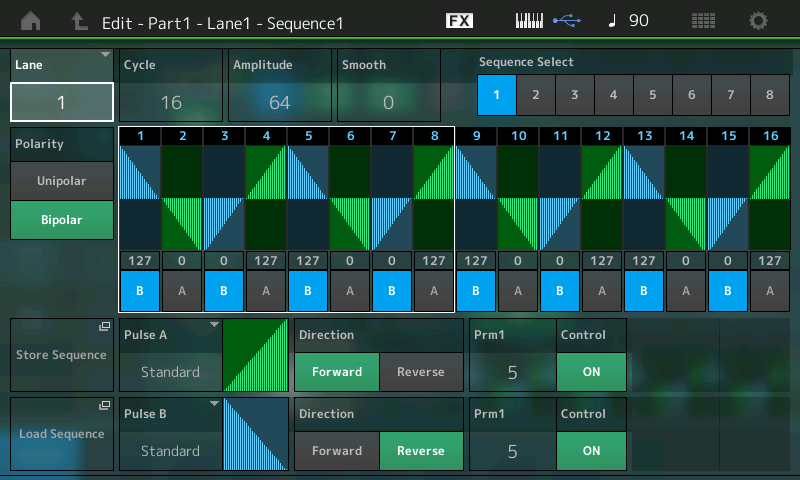Hi,
I'm translating in French the great Hans-Peter "review" on the Yamaha Music Production Guide 2016-02 about Motion SEQ for the next Moessieurs update
If i understanding fine :
- 8 parts of a performance can use the "Motion Seq" in simultaneous way.
- Each part can have independant 4 Lanes.
- But in a performance, 8 Lanes max can be used simultaneously.
So we can use with Motion Seq : 8 parts with 1 Lane for Each part.
Or 7 parts : 1 with 2 Lanes and 6 with 1 Lane.
Or 6 Parts ; 2 with 2 Lanes and 4 with 1 Lane or another example 1 with 3 Lanes 5 with 1 Lane.
......
Or for another example 2 parts, each part with 4 Lanes.
Does i understand fine ?
Another question.
Can we use the Scene Memory to memorize "Lane activation", for example :
Scene 1 : Part one 2 Lanes activated, Parts 2 to 7 one Lane activated.
Scene 2 : Part one 1 Lane activated, Parts 2 to 8 one Lane activated.
Scene 3 : Part1 One no Lane activated, Part 2 two lane activated, part3 to 8 one Lane Activated .
........
Joel wrote:
Hi,
I'm translating in French the great Hans-Peter "review" on the Yamaha Music Production Guide 2016-02 about Motion SEQ for the next Moessieurs updateIf i understanding fine :
- 8 parts of a performance can use the "Motion Seq" in simultaneous way.
- Each part can have independant 4 Lanes.
- But in a performance, 8 Lanes max can be used simultaneously.So we can use with Motion Seq : 8 parts with 1 Lane for Each part.
Or 7 parts : 1 with 2 Lanes and 6 with 1 Lane.
Or 6 Parts ; 2 with 2 Lanes and 4 with 1 Lane or another example 1 with 3 Lanes 5 with 1 Lane.
......
Or for another example 2 parts, each part with 4 Lanes.Does i understand fine ?
yes, but....
The problem with writing/analyzing it like this is that it is not necessarily how it will be used. People often make this mistake when trying to approach something new and different. I guess it is just human nature.
_ If I tell you that a maximum of 256 samples can be mapped across the Motif XF keyboard. And that two samples can occupy a key (for stereo)... You could correctly conclude that each Key C-2 through G8 could hold a stereo sample. Yes, that is true, but no one would necessarily do that in practical use.
_ If I tell you that a maximum of 256 samples can be mapped to any single Key on the Motif XF and that two samples can occupy a Keybank (for stereo)... You could correctly conclude that at each velocity value one could map a stereo sample. Yes, again that is true, but no one would do that. Practical use is somewhere in between.
Often the "in theory" maximums are NOT how the limits are used. Somewhere "in between", is where everything falls. Since no instrument can play a 128 note range, and since placing different samples at velocity of 1 and another at velocity 2 would just be a silly waste of memory... You get the idea that "in practice" that is not how the theoretical limits are used.
All that to say this, while no one has seen/knows all of the ways Motion Sequences will be used, we can go out on a limb and carefully state that this is going to be a similar thing... where how you actually wind up using it is somewhere "in between".
For example, here's the theory:
You can assign up to eight desired Sequence types for any one Lane.
You can also set up to four Lanes corresponding to the Motion Sequencer function for one Part.
Up to eight Lanes can be used at the same time for the entire Performance... simultaneously.
You can construct these Sequences manually or select from preset Sequences. They are up to 16 Steps. Each step with a control value. The shapes and nature of these Sequence steps is wildly programmable. They can be set to loop, or they can be triggered manually, or at each key on, or just the first key on, etc., etc., etc. they can be sync'd to tempo, follow the arpeggiator, run freely... Tempo and timing offsets can be applied (like PLAY FX in the XF) allowing you great flexibility in how they feel when applied to the synth. You can sharpen and/or amplify their influence on the target.

Press [EDIT SEQUENCE] to drop into detailed editing of the Sequence:

"- 8 parts of a performance can use the "Motion Seq" in simultaneous way."
Yes, each Part under Keyboard Control can use the Motion Sequencer. Although that probably will not be how it is used.
"- Each part can have independant 4 Lanes."
A Lane is best understood as a pathway to a control Destination. Lane 1 might be controlling Element Pan, Lane 2 might be controlling Element Volume, Lane 3 might be controlling Cutoff Freq, Lane 4 might be controlling LFO Speed. Each Lane can have as many as 8 Motion Sequences associated with it... A Motion Sequence is applied very much like an Arpeggio (the Motif XF used SF1-SF5; in Montage there are 8 Motion Seq buttons 1-8. Select Motion Seq 1 a specific rhythm situation applies the data; select Motion Seq 2 a different rhythmic situation will be recalled. Each sequence can be from 1 to 16 steps and applies a control.
If Lane 1 is assigned Element Pan. Motion Sequence 1 might pan the element left and right at a rate of once per measure, while Motion Sequence 2 might do this in a unique rhythmic way that takes 4 measures to complete, and Motion Sequence 3 might pan it 3 times a measure, etc., etc., etc., 8 different panning setups recalled, one at a time.
If additionally we activate Lane 2 for this Part doing volume, 8 different rhythmic movements of volume can be recalled because there are 8 Motion Sequences. Say the first Seq is volume rapidly up and down with a specific groove rhythm... Seq 2 double times the loud soft movement, and so on...
Motion Sequencer button #1 will recall the left/right once per measure Pan (Lane 1) and the volume rapidly up and down with your specified groove (Lane 2). And so on...
Because a Part can utilize four Lanes does not mean you will apply that many to a Part. Panning the Element might be enough. Certainly panning, and volume, and cutoff and LFO speed might be overkill for a single Part, but you could use all four pathways to assign control on this one Part... But that would leave you just four other pathways (Lanes) you could establish elsewhere for this Performance.
"- But in a performance, 8 Lanes max can be used simultaneously."
That is correct. Until you actually work with these Motion Sequences and realize their affect, will you truly have a concept of how you will/can use them. It's all theory until that time. In actual use, rarely will each of the 8 Parts have an assigned Lane... This is not to say you couldn't, it's just that situation where it is not likely.
Now there is an addition here... It is 8+1 when it comes to the overall limit. The Super Knob has its own dedicated Motion Sequence which can be used to automate the parameters assigned to it... This is in addition to the Motion Sequences available to the individual Keyboard Controlled Parts.
Another question.
Can we use the Scene Memory to memorize "Lane activation", for example :
Scene 1 : Part one 2 Lanes activated, Parts 2 to 7 one Lane activated.
Scene 2 : Part one 1 Lane activated, Parts 2 to 8 one Lane activated.
Scene 3 : Part1 One no Lane activated, Part 2 two lane activated, part3 to 8 one Lane Activated .
........
No, SCENE Memory can recall a Motion Sequence, similar to or exactly like a SONG SCENE in the XF could recall an Arpeggio (there were only five in the XF) here, a SCENE can recall any of the 8 Motion Sequences assigned to a Lane, and any of the 8 Arpeggio phrases, in addition to all the other mix parameters, mutes, settings, etc., etc., recalled by the Scene.
A Lane cannot be so easily activated/deactivated as it represents an assignment pathway from the Motion engine to a specific parameter. Think of it as a patch cable on a modular synth, you've connected a control source to a parameter destination... via this Lane.
Example:
Part 1... Lane 1 is between the Motion Sequence and Element Pan... You can create 8 different movements for panning, recalled by Motion Seq buttons [1]-[8] or assigned to Scene buttons 1-8
Simultaneously Lane 2 is patched to Volume... You can create 8 different movements for volume change, recalled by Motion Seq buttons [1]-[8] or assigned to Scene buttons 1-8
Simultaneously Lane 3 is patched to Cutoff...
And Lane 4 to INSERT "A" LFO Speed...
When Motion Sequence #1 is recalled Part one is panning, volume changing, cutoff frequency being swept, and the effect's LFO speed are all being automated by the #1. Each Part can have 4 Lanes maximum (you probably will not use all four); each Lane can have 8 Sequences. So at maximum, there can be 32 different configurations of the 16 step cycles.
Thank you Phill for this another great answer.
Yes i try to analyze and understand, without the Montage in hands, it's difficult to "feel" how it's work.
I wasn't understanding the part of the 8 sequences in one Lane link to the Motion Seq button 1-8 before you explain it.
Yes of course also, i think i will not use 4 lanes for one part.
Interesting also to know that the Super Knob have is own dedicated Motion Seq.
It's more clear now, but i think i will completly understanding when the Montage will be at home by testing
Thank you.
Joël

